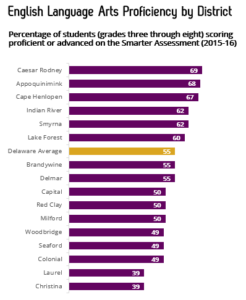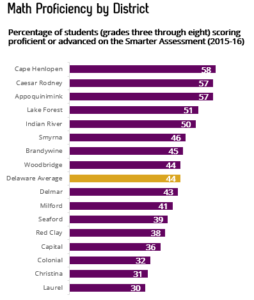6 Big Takeaways from Smarter Balanced Scores
by Liz Hoyt and Shyanne Miller
Last week, Delaware officially released preliminary statewide results for public school students on the Smarter Assessment and the SAT. We took a look at the data, and pulled out six big takeaways from this year’s results.
- Delaware students made incremental gains in year two of the Smarter Assessment. Preliminary Smarter Assessment results for students in grades three through eight show that 55 percent of students are proficient in English language arts, and 44 percent of students are proficient in math. As compared to last year, there was a three percentage point increase in students achieving grade-level proficiency.
- The Smarter Assessment is tougher by design. As we noted last year, this not the average multiple choice test. It requires students to complete performance tasks and think critically, reflecting the challenges students will face in college or the workplace. Continued long-term effort is needed to make improvements from year to year.
- The Smarter Assessment results are comparable across Delaware schools and 14 other states, indicating whether students are on-track to succeed in high school. Smarter is the one assessment that is consistent statewide, for students in grades three through eights. This comparability creates opportunities to identify what’s working and share practices so that more students can benefit.
Furthermore, this assessment is benchmarked to national standards and allows us to compare Delaware students with 14 other states, helping us understand whether students are on-track to thrive in high school, the workplace, and college.
- According to preliminary SAT results, roughly half of 11th graders are college ready in English, and less than a third are college-ready in math. Preliminary results for the SAT show that 53 percent of 11th graders are college ready in English language arts, and 31 percent are college ready in math. The 2015-16 school year marks the first year that the SAT had replaced Smarter Balanced, making it the only statewide assessment of high school math and English proficiency. This year’s SAT has been redesigned, and these preliminary results are based on proposed cut scores for proficiency that have yet to be approved by the State Board of Education.
- Improved data analytics and score reports may help teachers and parents support students. The improved Smarter Analytics System gives teachers access to more detailed information on students results, allowing for them to measure what level each student is on in English and math classes. This provides opportunities for teachers to better meet individual student needs.
Parents will also have access to a more detailed Delaware Parent Guide on how their children scored on the test, including information on how the student is progressing through the standards and resources for supporting them in their learning.
- Focus on the whole student, not just the test. Statewide test scores are important, but they’re just one of many indicators of student success. Delaware is making progress across a variety of indicators of postsecondary success, including: high school graduation rates, early college and career experience, and college and workforce participation. For more information, check-out Rodel Issues & Resources on College and Career Readiness.
Stay tuned for further analysis and results!



